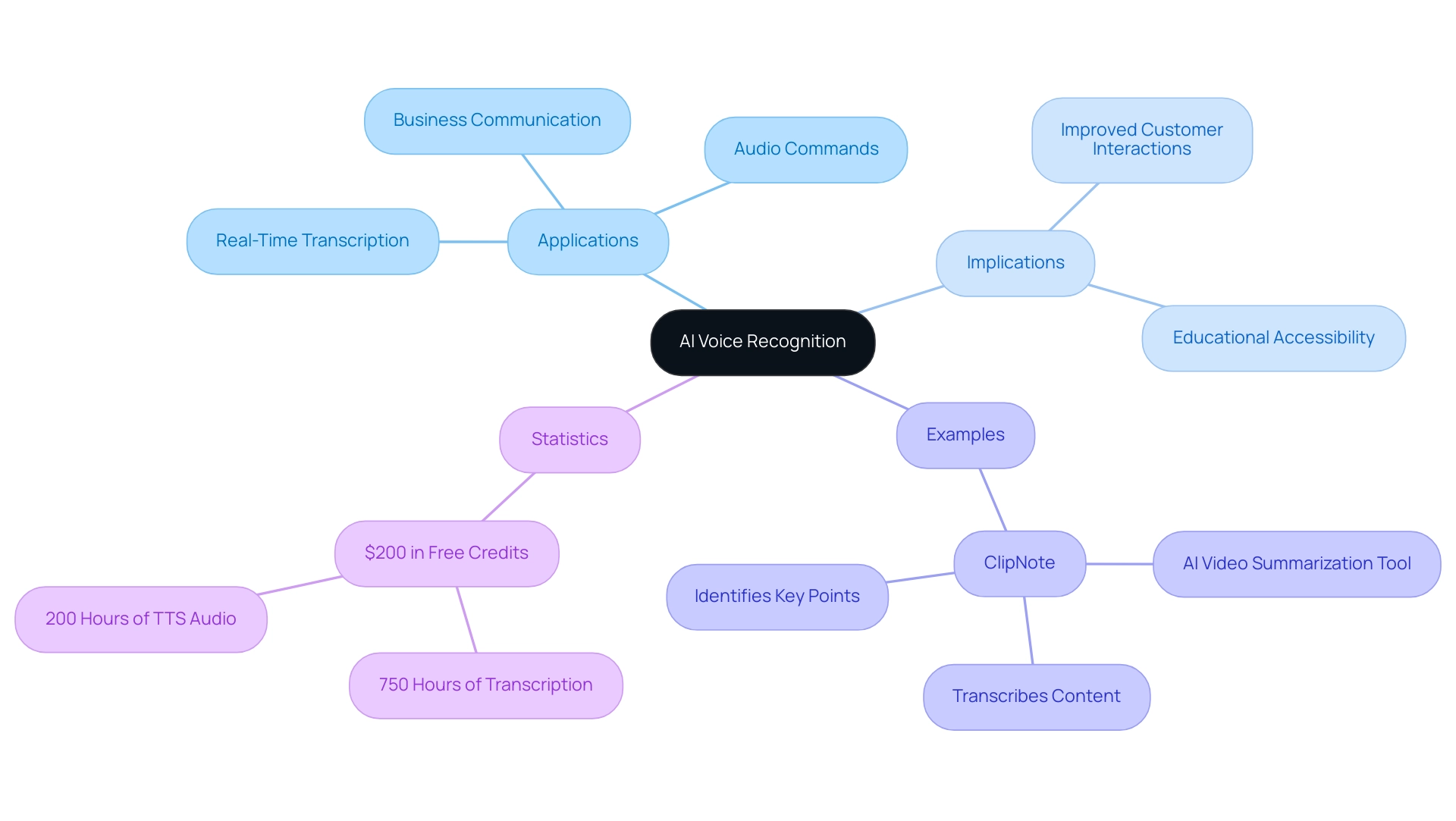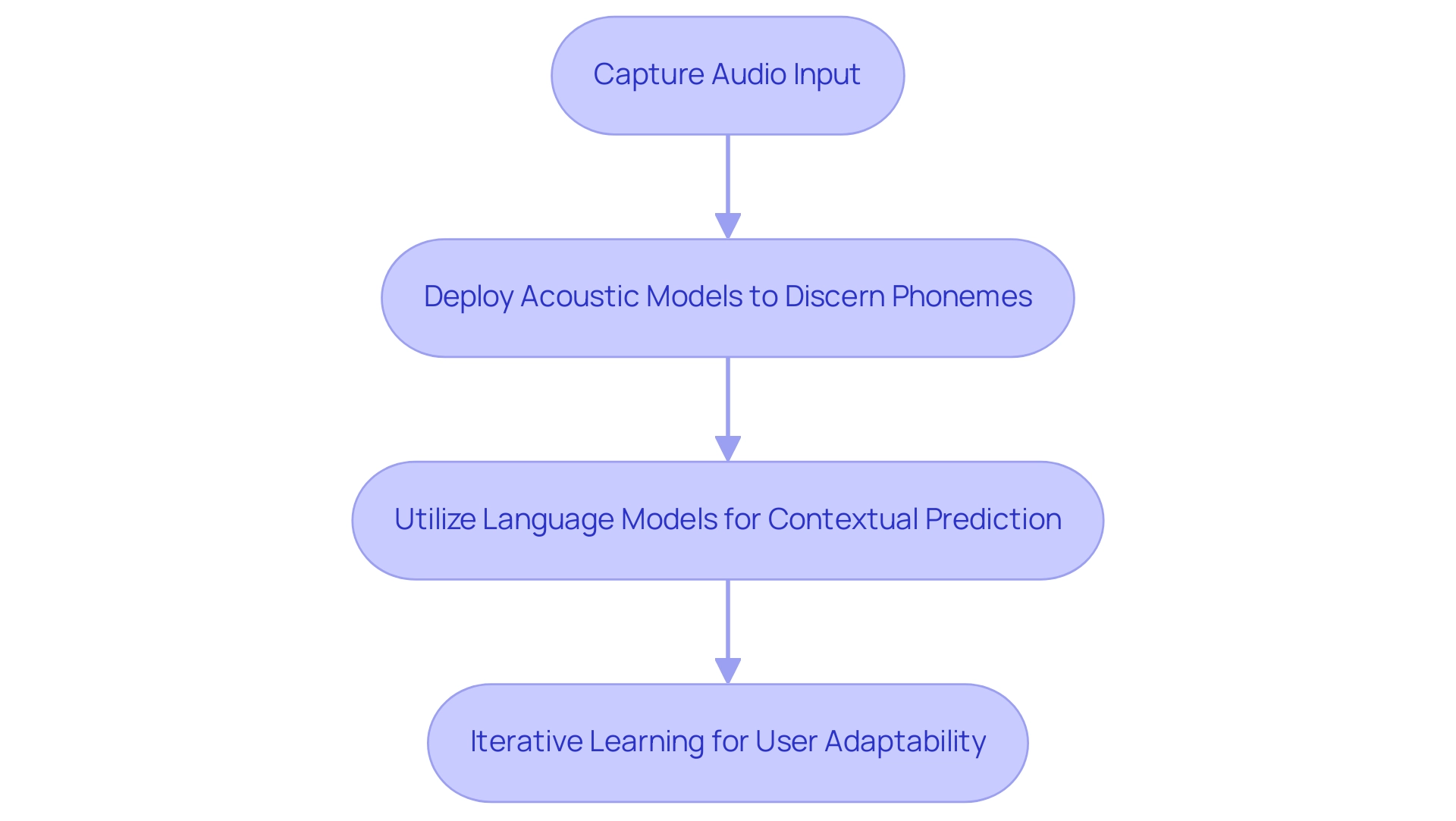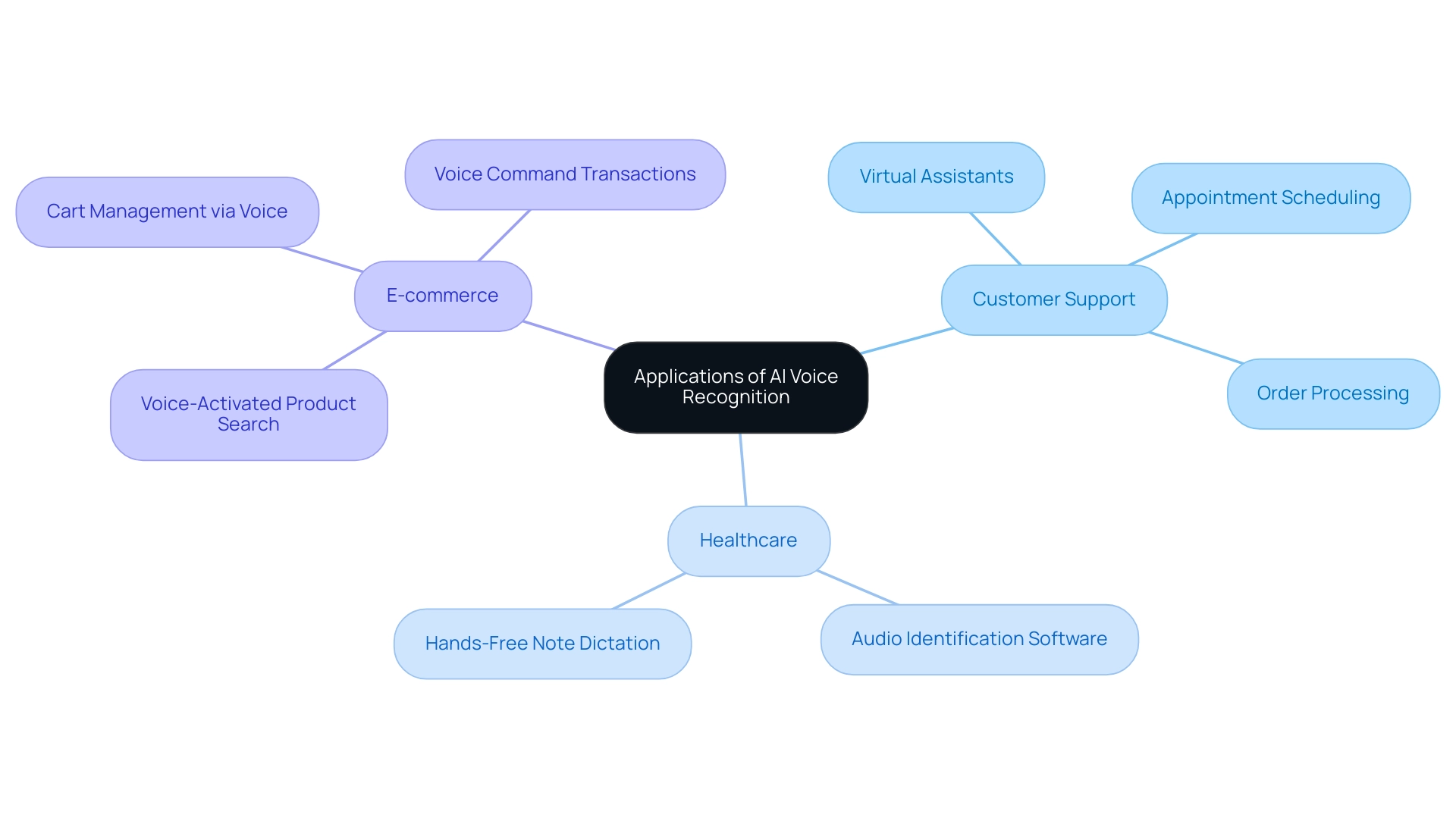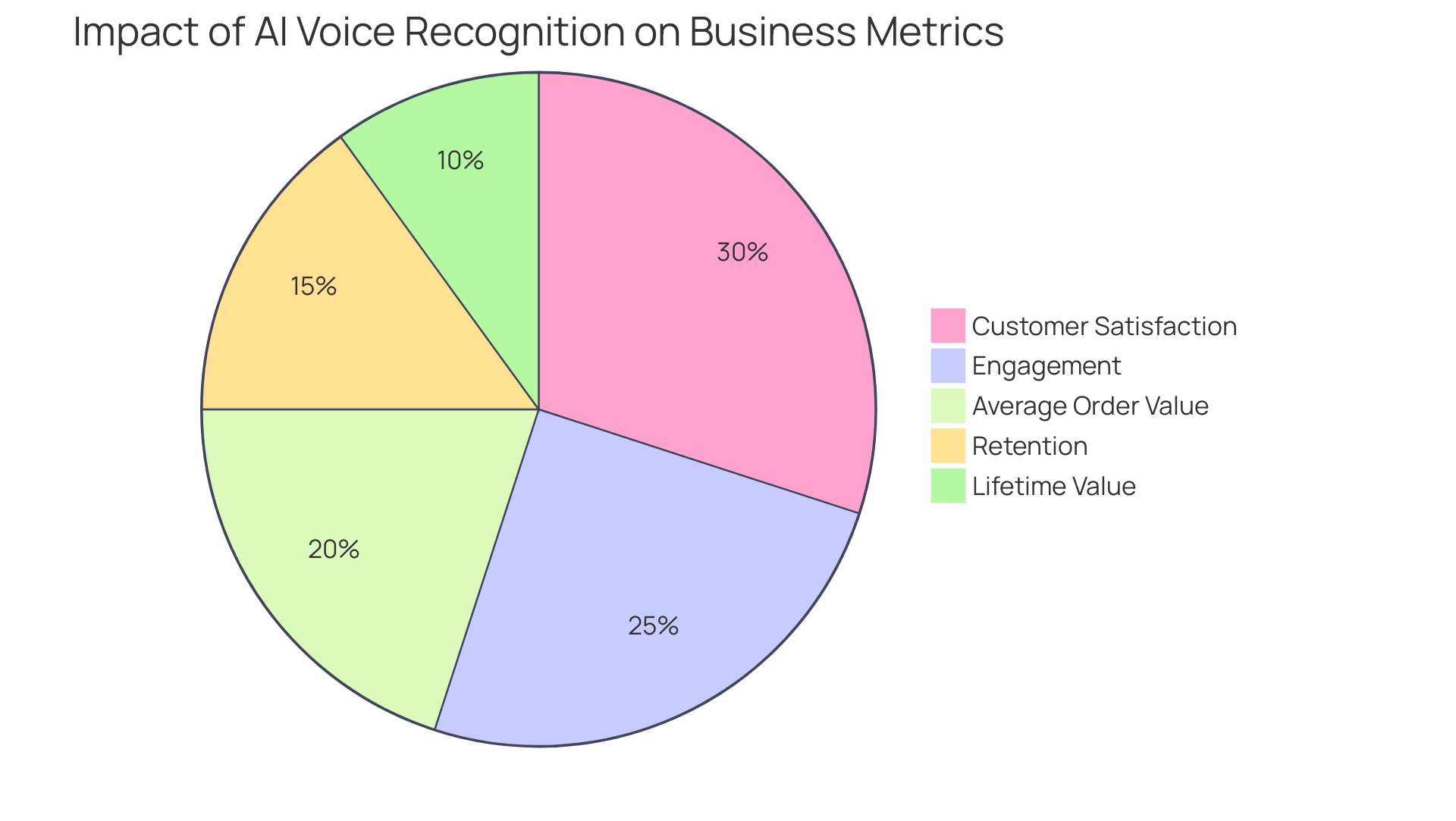Introduction
In an era where communication is increasingly digital, AI voice recognition technology stands at the forefront of innovation, transforming the way businesses interact with customers and streamline operations. This sophisticated technology not only enables devices to understand and process human speech but also enhances productivity by minimizing misunderstandings and fostering smoother interactions. As organizations harness the power of AI voice recognition, they unlock a myriad of applications—from efficient customer service solutions to hands-free documentation in healthcare—that are reshaping industries.
With its rapid advancements and growing accessibility, the implications of this technology are profound, promising personalized user experiences and improved operational efficiencies. As the landscape continues to evolve, understanding the mechanics and benefits of AI voice recognition becomes essential for any business aiming to thrive in the modern marketplace.
Understanding AI Voice Recognition: An Overview
AI speech recognition systems, which allow devices to understand and interpret human language, have experienced significant progress. Today, it supports real-time transcription, audio commands, and interaction with various applications. Businesses can utilize this innovation to foster smoother interactions, minimize misunderstandings, and boost overall productivity. Experts in the field emphasize that AI auditory recognition will transform business communication by enabling more efficient customer interactions and personalized service experiences.
Danielle Chazen emphasizes its wider implications, stating,
As advancements recognize sounds, their tones, and their contexts more distinctly, criminal acts and legal procedures will become more transparent, and higher education will be more tailored and accessible.
A notable example is ClipNote, an AI video summarization tool that transcribes content and identifies key points using natural language processing, saving users significant time by providing concise summaries of lengthy videos. With speech identification advancements expected to expand, it provides more customized experiences and secure online transactions.
Current statistics show that $200 in free credits can fuel transcription for 750 hours or generate TTS audio for approximately 200 hours, underscoring its cost-effectiveness and efficiency. These capabilities not only boost operational productivity but also enhance customer satisfaction and engagement, making the incorporation of AI auditory identification into your communication strategy essential for success.

How AI Voice Recognition Works: The Technology Behind the Tool
AI auditory identification systems operate through a complex interaction of algorithms created to convert spoken language into text. Central to this process are machine learning and natural language processing (NLP) techniques, which refine accuracy over time. Initially, the system captures audio input and deploys acoustic models to discern phonemes—the fundamental sound units. Subsequently, it utilizes language models to predict the most probable words based on contextual cues. This iterative learning process enables AI systems to adjust to user interactions, improving their capacity to understand various accents and speech patterns.
Recent advancements in machine learning have greatly strengthened the precision of audio identification technology. For example, a report from 2024 suggests that accuracy rates in AI auditory processing have enhanced by over 30% compared to prior years, mainly due to the adoption of deep learning algorithms and larger training datasets. Voiceitt, a groundbreaking Israeli firm, has created a speech analysis system that utilizes customized sound models to support individuals with speech difficulties. Originally launched as a vocal translator application in 2021, Voiceitt's innovations now integrate with remote work platforms such as WebEx, ChatGPT, Zoom, and Microsoft Teams, thus facilitating effective communication and expanding job opportunities for users facing communication barriers.
To further illustrate the advancements in audio recognition, Dr. Alice Thompson, a leading expert in AI algorithms, notes, 'The evolution of deep learning techniques has fundamentally transformed the landscape of audio recognition, allowing for unprecedented levels of accuracy and user adaptability.' Enhancing accessibility remains a pivotal goal for AI auditory technology. As Hope Gerlach-Houck, an assistant professor of speech, language, and hearing sciences, aptly states, 'And making audio AI accessible is a critical piece of the puzzle.' This dedication to accessibility guarantees that AI-driven auditory systems are not only progressing technologically but also making the advantages of AI available to a broader array of users.

Applications of AI Voice Recognition: Transforming Communication Across Industries
AI auditory identification is transforming communication across various industries, especially in customer support, healthcare, and e-commerce. In customer service, current applications include:
- Virtual assistants that can handle routine inquiries
- Schedule appointments
- Process orders
This allows human agents to focus on more complex issues. This technological advancement is underscored by the significant adoption of AI services, which saw a 270% increase between 2015 and 2019. Experts stress that by simplifying communication, AI auditory processing not only improves response times but also boosts customer satisfaction.
In healthcare, the technology allows medical professionals to dictate notes and records hands-free, significantly improving workflow and reducing administrative burdens. Existing applications encompass:
- Audio identification software that converts doctor-patient discussions into electronic health records (EHRs), ensuring precision and efficiency.
This enhancement in efficiency is vital in a sector where time is of the essence. Additionally, the possibility for AI audio identification to change healthcare documentation is backed by Kateryna Cherniak, who observes that worldwide, 38% of consumers hold a favorable opinion of digital assistants. Furthermore, healthcare experts have indicated that utilizing speech identification systems can lessen documentation time by as much as 50%, providing more time for patient care.
E-commerce companies are also utilizing the capabilities of AI voice recognition to establish voice-activated shopping experiences, allowing individuals to:
- Search for products
- Add items to their cart
- Finalize transactions through straightforward voice commands
These present applications enhance customer engagement and streamline the shopping process, reflecting the system's capacity to boost communication efficiency and customer satisfaction. However, it is essential to address concerns over AI transparency and potential biases, as highlighted by a PwC survey, which found that 76% of CEOs are worried about these issues. These concerns highlight the necessity for greater accountability and clarity in AI development and deployment, ensuring that the advancements continue to benefit various sectors without compromising ethical standards.

Benefits of AI Voice Recognition: Enhancing Communication Efficiency and User Experience
Embracing AI auditory identification innovations presents numerous benefits to companies, ranging from increased efficiency to shorter response times and an overall enhanced user experience. Our tailored e-commerce solutions, backed by over 20 years of global experience, allow businesses to automate routine communication tasks through AI, reallocating resources more effectively and empowering teams to concentrate on strategic initiatives.
A 2024 study indicates that businesses utilizing AI auditory identification observed:
- A 30% increase in customer satisfaction
- A corresponding 25% boost in engagement, directly correlating to revenue growth
Furthermore, these implementations have been shown to enhance retention rates by 15%, increase Average Order Value (AOV) by 20%, and improve Lifetime Value (LTV) by 10%, demonstrating a clear impact on critical KPIs.
Cheryl Porter, President of AWWA, highlights the transformative influence of such innovations, stating,
'AI auditory identification not only improves operational efficiency but also promotes inclusivity, ensuring that all customers can interact seamlessly with businesses.'
Additionally, case studies such as AWWA’s Water Equation initiative illustrate how investing in workforce advancements through technology can address critical gaps in service delivery, resulting in a 40% improvement in service response times.
By integrating AI voice recognition, businesses can create a more efficient, accessible, and profitable environment, aligning with the goals of enhancing customer service and e-commerce engagement while building community value.

Conclusion
AI voice recognition technology is not just a passing trend; it is a fundamental shift in how businesses engage with customers and optimize their operations. By harnessing sophisticated algorithms and machine learning capabilities, organizations can enhance communication efficiency, reduce misunderstandings, and foster a more personalized user experience. The technology's applications span diverse industries, from streamlining customer service interactions to revolutionizing healthcare documentation, each showcasing its potential to transform traditional processes.
As businesses increasingly adopt AI voice recognition, the benefits become evident. Enhanced customer satisfaction, improved operational efficiencies, and significant cost savings are just a few of the advantages that drive organizations to integrate this technology into their communication strategies. The data supports these claims, with notable increases in customer engagement and retention rates, underscoring the technology's impact on key performance indicators.
In conclusion, the integration of AI voice recognition is essential for businesses aiming to thrive in today's digital landscape. As technology continues to evolve, embracing these advancements will not only lead to improved interactions but also position organizations as leaders in their respective industries. Adopting AI voice recognition is not merely a technological upgrade; it is a strategic imperative that promises to elevate customer experiences and drive sustainable growth.





